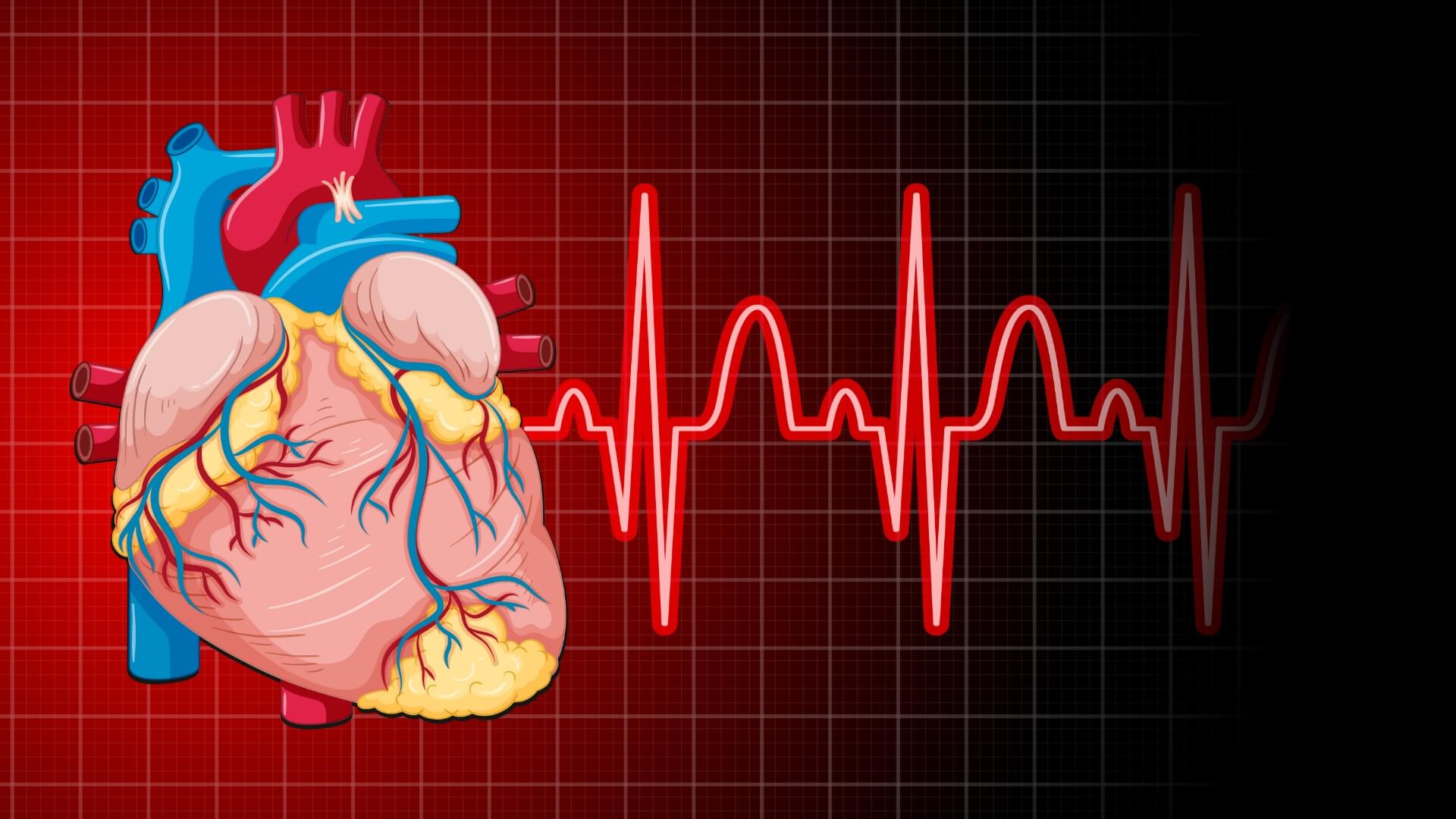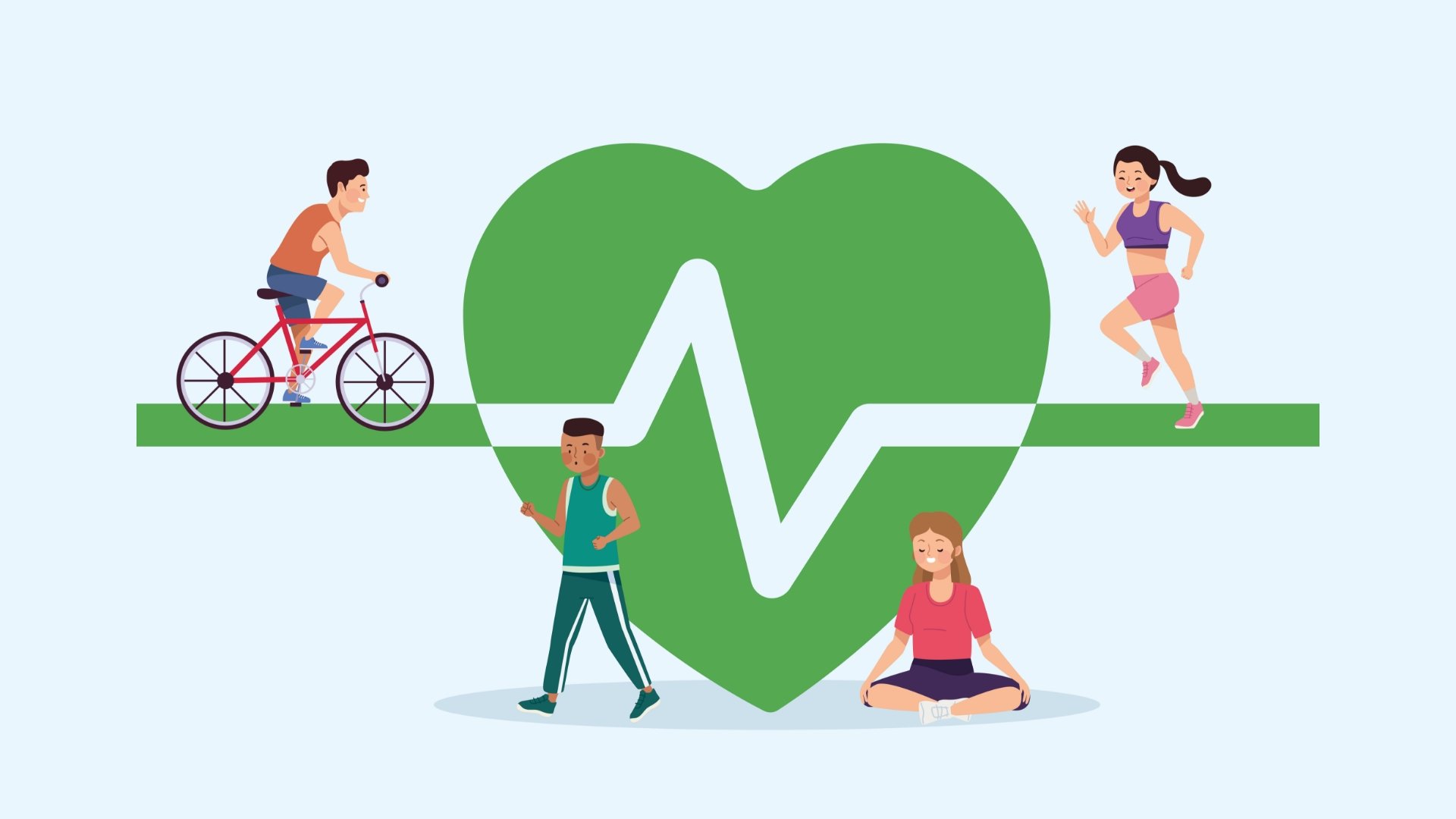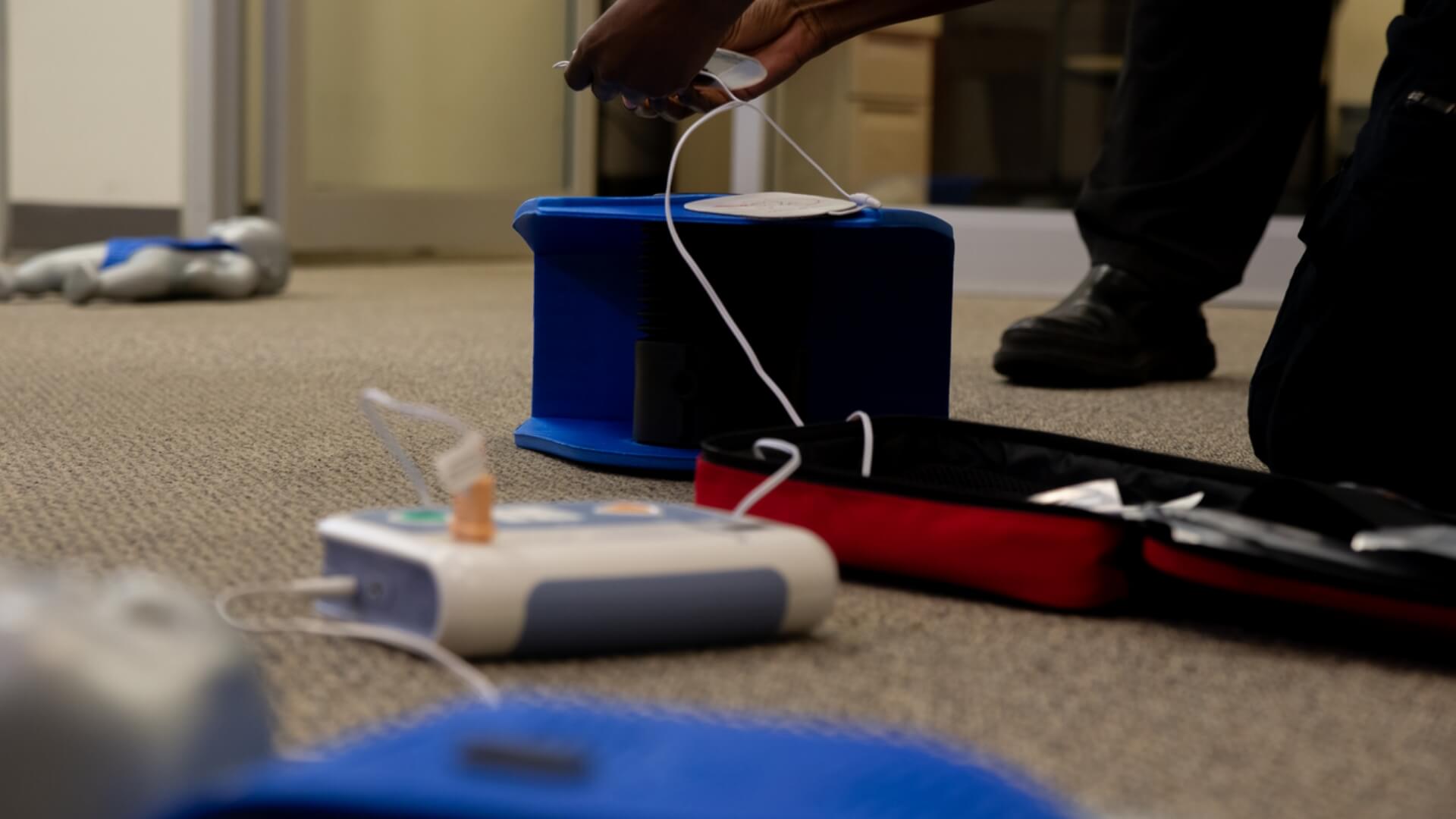An automated external defibrillator (AED) is a life-saving device. It quickly checks the heart rhythm of someone in sudden cardiac arrest. If it finds a shockable rhythm, the AED gives an electric shock to restore a normal heartbeat. What is a shockable rhythm? What happens when those risky patterns are absent? If you use or maintain an AED, it’s important to understand this difference.
- How the heart works
- What happens in cardiac arrest
- Which rhythms are shockable
- Which rhythms are not shockable
- What to do in the event of a cardiac arrest
How the heart works
To see why only some heart rhythms respond to a shock, we should first look at how the heart works. Acting as the body’s natural pump, it keeps blood circulating continuously. In just one day, it beats nearly 100,000 times. That totals about 40 million beats each year and an amazing three billion over a lifetime.
Like a hydraulic pump, the heart moves blood through three connected systems. These systems keep blood flowing and supply oxygen to the body:
- Electrical: The heart’s electrical system generates the impulses that keep it beating. This network relies on natural pacemakers, each firing at its own pace. When one pacemaker fails to trigger, another steps in to maintain the rhythm.
- Mechanical: This refers to the contraction of the heart muscle. The organ has four chambers. The upper two are called atria, and the lower two are ventricles.
- Hydraulic: The hydraulic element of the heart is the blood itself. Each chamber must fill and empty all the time. This way, oxygen goes to the body, and carbon dioxide is removed by the lungs.
What Happens in a Cardiac Arrest
Cardiac arrest happens when a vital part of the heart doesn’t function properly. This can be due to issues with its electrical, mechanical, or hydraulic systems. Effective treatment starts with knowing which system has failed. Then, it’s crucial to provide the right support. This helps keep the person alive until emergency responders arrive.
Cardiac arrest caused by an electrical malfunction.
Most cardiac arrests that happen outside hospitals start with an issue in the heart’s electrical system. When this system fails, the heart muscle can’t contract. Its chambers stop pumping blood. Without circulation, vital organs, like the brain, can’t get oxygen. Irreversible damage starts within minutes.
Cardiopulmonary Resuscitation for Cardiac Arrest
In the first moments after a sudden cardiac arrest, CPR helps keep blood flowing. This ensures oxygen reaches vital organs. This circulation protects the brain. It slows organ decline and boosts survival chances until advanced care arrives.
A trained person can give rescue breaths with chest compressions. If the rescuer is untrained, they should give continuous compressions. Aim for a steady rhythm of 100 to 120 per minute. This speed is about the same as the song “Stayin’ Alive.”
Defibrillation for cardiac arrest.
If an automated external defibrillator (AED) is on hand, it can do an electrocardiogram (ECG or EKG). This helps check for one of the two shockable rhythms. If the heart has a shockable rhythm, the user should ensure no one is touching the patient. Press the shock button if you’re using a semi-automatic model, such as the HeartSine Samaritan PAD 350P. If it is a fully automatic model, like the Physio-Control LIFEPAK CR2, wait for it to deliver the shock.
A defibrillator shock doesn’t make the heart start beating like in movies. It works differently than those dramatic “jump-start” scenes. It resets the heart’s natural pacemakers. It’s like pressing the restart button on a computer to get things working normally again.
Non-Electrical Causes of Cardiac Arrest
Other kinds of cardiac arrest, like those from severe blood loss or heart muscle problems, won’t react to electric shocks. This is because the problem isn’t in the heart’s electrical system.
Extreme Blood Loss
When severe blood loss leads to cardiac arrest, stopping the bleeding is the top priority. One person should call emergency services. Meanwhile, the rescuer can use a bleeding control kit if available. If not, they should apply firm, direct pressure and elevate the injured limb to slow the bleeding. Once bleeding is managed, CPR can then be started to maintain circulation.
When medical professionals arrive, they can restore lost volume. They stabilize the patient by using intravenous fluids or a blood transfusion.
Heart muscle malfunctions.
If there are electrical signals but the heart muscle does not contract, it could be due to tension pneumothorax or cardiac tamponade. In these cases, treatment typically involves specialized interventions provided by emergency medical teams.
- Chest compressions
- Bag-valve mask ventilation
- Needle decompression (in the case of a pneumothorax)
- Epinephrine
Keep the AED connected while you wait for emergency responders. Continue CPR to support circulation until help arrives.
Shockable Rhythms
Knowing how the heart works and what sudden cardiac arrest is helps explain why only some rhythms respond to shock treatment. In cardiac arrest due to electrical issues, an AED can detect two shockable rhythms.
- Ventricular fibrillation
- Pulseless ventricular tachycardia
Ventricular Fibrillation
Ventricular fibrillation, or V-fib, is the leading cause of sudden cardiac death. In this state, the ventricles, the heart’s lower chambers, twitch instead of contracting. It’s like a heart seizure. Some movement is there, but the heart doesn’t pump effectively.
Ventricular fibrillation usually comes from problems in the heart’s electrical system. It can also occur after muscle damage, such as during a heart attack. This stops normal impulses. Defibrillation stops the chaotic heart rhythm. This allows the heart’s main pacemaker to restore a normal beat.
Pulseless Ventricular Tachycardia
Pulseless ventricular tachycardia, or V-tach, is a shockable rhythm. It can cause cardiac arrest. In this state, the ventricles fire quickly. They do this without direction from the heart’s main pacemaker. As a result, the muscles can’t contract well or fill with blood. As a result, circulation fails and the pulse eventually disappears.
Pulseless ventricular tachycardia can happen due to various reasons. It’s often linked to serious heart problems. These issues can disrupt normal electrical activity.
- Coronary artery disease
- Valvular heart disease
- Cardiomyopathy
- Long QT syndrome
- Brugada syndrome
- Certain drugs and medications
- Electrolyte imbalances
Pulseless V-Tach vs. V-Tach with a pulse
Ventricular tachycardia can happen with a pulse if the heart muscle contracts well. In this situation, the patient is not in cardiac arrest and does not need a shock.
Begin chest compressions right away for anyone who is unresponsive and not breathing normally, as stated in the American Heart Association’s 2020 CPR guidelines. It’s hard for lay rescuers to check for a pulse, so don’t pause to feel for one. It’s much safer to give compressions than to skip CPR for someone without a pulse. The same goes for defibrillation.
Unshockable Rhythms
As there are two rhythms that can be treated with a shock, there are also two that cannot.
- Pulseless electrical activity (PEA)
- Asystole
Pulseless Electrical Activity
Pulseless electrical activity happens when the heart’s electrical system is active, but the muscle or blood volume can’t pump well. Causes may include severe blood loss, tension pneumothorax, or cardiac tamponade. In these cases, a shock is ineffective because the issue is not electrical in nature.
Asystole
Asystole, or flatline, is when the heart shows no electrical activity at all. It can occur after long episodes of ventricular fibrillation or if the heart muscle has died.
Asystole cannot be corrected with a shock since there is no electrical activity to reset. Survival hinges on fast, effective CPR and treatment of the cause. Thus, bystanders should maintain compressions until emergency responders arrive.
What to Do in the Event of Cardiac Arrest
In a cardiac arrest outside a hospital, act fast. This is key to saving a life until help arrives.
- Call 9-1-1
- Attach a portable defibrillator to the patient’s bare chest via the adult electrode pads or pediatric pads for an infant or small child
- Turn the device on
- Follow the instructions
The AED helps the rescuer keep doing chest compressions. This keeps blood flowing to vital organs. It also pauses at times to check the patient’s heart rhythm.
Shock Advised
If the AED detects a shockable rhythm, it instructs bystanders to stand clear. A fully automatic model delivers the shock automatically. In contrast, a semi-automatic device tells the rescuer to press the shock button.
No shock is advised.
If the AED finds a non-shockable rhythm, it will say, “No shock advised.” Then, keep doing chest compressions. Trust the device. It checked the rhythm and found that the heart’s electrical activity is normal or absent. In both cases, a shock will not help.
After a “no shock advised” message, it is crucial to keep the AED attached and powered on. The device will keep watching the heart and guide CPR. If the heart’s rhythm becomes shockable later, it will deliver a shock.
Remove the electrode pads from the patient only in specific situations. This should happen when it’s clear that continuing to use them isn’t appropriate.
- A transfer of care (the EMS personnel or hospital staff will remove the electrode pads when it’s safe to do so)
- Resuscitation efforts have ceased (again, only a medical professional can make this call)
Keep the defibrillator on and attached during a cardiac arrest. Continue chest compressions until help arrives. Compressions support life, whether the rhythm is shockable or not. They keep the patient stable until advanced treatment is available in the hospital.
Be ready to save a life.
If you run a place where people gather or exercise, a working AED on-site can save lives during a cardiac arrest. Many states need defibrillators and trained personnel. This is important in schools, gyms, dental offices, and public parks.
An AED management program helps organizations with many sites or many defibrillators. It keeps each device ready and up to date for emergencies. AEDs detect shockable rhythms. It is vital to maintain them so they can deliver lifesaving shocks when needed.
FAQs
What are shockable heart rhythms on an AED?
Shockable heart rhythms are risky electrical patterns. These include ventricular fibrillation and pulseless ventricular tachycardia. An AED can detect these rhythms and deliver a shock to help restore normal heart function.
Why are some heart rhythms shockable and others not?
Only rhythms caused by electrical malfunctions in the heart can be treated with a shock. Conditions like asystole or pulseless electrical activity are non-shockable. This means that CPR and medical treatment are needed instead.
Why are AEDs so expensive?
AEDs are life-saving devices. They use advanced technology to check heart rhythms. If needed, they can deliver shocks. They also provide voice-guided CPR instructions. Their cost reflects the precision, reliability, and safety standards needed for emergency use.
How does an AED know when to deliver a shock?
An AED uses built-in sensors to read the heart’s electrical activity. When it finds a shockable rhythm, it either delivers a shock on its own or asks the rescuer to press the shock button. This depends on the model.
Can a shock from an AED hurt someone who doesn’t need it?
Modern AEDs have safety checks. They won’t deliver a shock unless a shockable rhythm is detected. This prevents unnecessary shocks and ensures the device is used only when it can help save a life.
Conclusion
Recognizing shockable versus non-shockable rhythms is vital during sudden cardiac arrest. With an AED and good CPR, untrained bystanders can save lives. They can act quickly in those first crucial minutes before help arrives. Properly maintained AEDs and knowing how to use them boost survival chances when every second matters.



